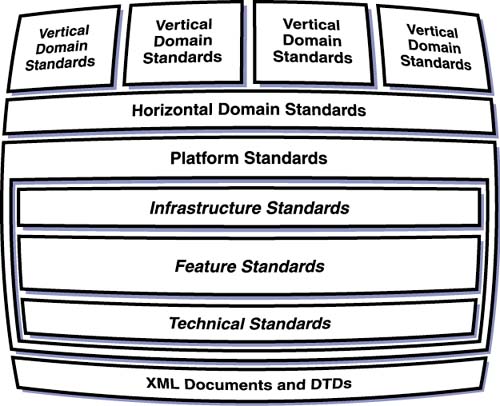Executive Summary
| XML documents and DTDs provide the foundation for an evolving Internet document paradigm. As people developed XML applications, they naturally identified additional features they wanted to have and troublesome drawbacks they wanted to avoid. Such discoveries inspired further standards efforts built on the foundation of XML documents and DTDs. As the use of XML has evolved, this process has led to a complicated landscape where old specification efforts languish for extended periods of time and new efforts rapidly achieve acceptance. Therefore, identifying the standards relevant to your needs can be something of a challenge. Categorizing the various specifications offers a potential aid to navigating the landscape. Figure 3-1 presents one potential categorization of XML- related standards. It expands on Figure 2-1 by revealing the detailed structure of both the platform standards and the domain standards. This categorization can help you identify the depth of understanding you need for any given standard. Figure 3-1. Categories of Related Standards The line between platform and domain standards is somewhat fuzzy. As a rule of thumb, platform standards potentially add capabilities to XML documents of all types, while domain standards define an XML format to encode information for a narrower purpose. In general, a standard that could ultimately affect a majority of XML developers is probably a platform standard. Within this category, there are three subcategories .
It is important to have a thorough understanding of feature standards because they will help you to determine whether XML supplies the capabilities necessary to solve a given business problem. On the other hand, most managers only need to understand technical and infrastructure standards at a very high level. A general knowledge of technical standards could help you understand the source of a defect in a third-party component that delays a project. A general knowledge of infrastructure standards could help you ensure that your developers maximize the use of existing solutions. Detailed comprehension of technical and infrastructure standards is usually necessary only for developers working with software components that implement them. Figure 3-1 also shows the structure of the domain standards. The XML paradigm includes both horizontal and vertical domain standards. Horizontal domain standards provide a solution for manipulating information specific to a type of application but used in many industries. Examples include portable formats for vector graphics ( SVG ), multimedia ( SMIL ), and mathematical expressions ( MathML ). They generally facilitate common software components across different industries. Their applicability depends on whether your application manipulates the particular type of data they describe. The vertical domain standards provide formats for describing information specific to a particular industry but used by many types of applications. Examples include interoperability formats for finance, health care, and telecommunications. They generally facilitate compatibility among systems used within the same industry. Their applicability depends on whether your organization works with information from a particular industry. Table 3-1. XML Feature Standards
Table 3-1 lists the most important feature standards. The rest of this chapter reviews the important details of these standards. At the end of the chapter, there is a summary of key technical and infrastructure standards. |
EAN: 2147483647
Pages: 75
- Challenging the Unpredictable: Changeable Order Management Systems
- The Second Wave ERP Market: An Australian Viewpoint
- The Effects of an Enterprise Resource Planning System (ERP) Implementation on Job Characteristics – A Study using the Hackman and Oldham Job Characteristics Model
- Context Management of ERP Processes in Virtual Communities
- Healthcare Information: From Administrative to Practice Databases
